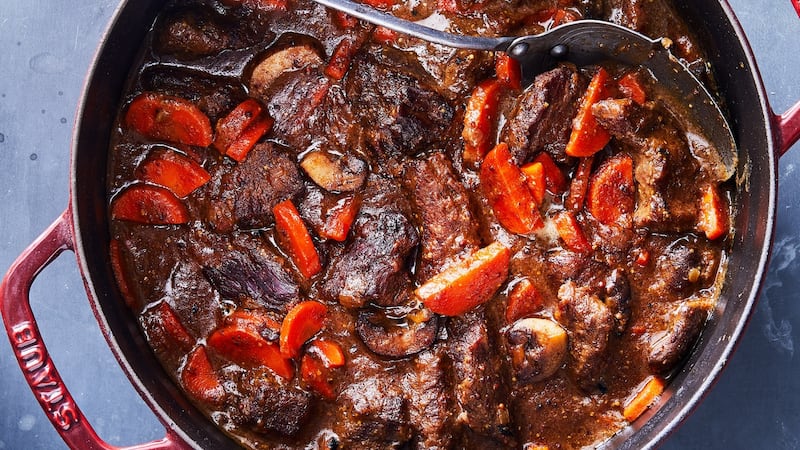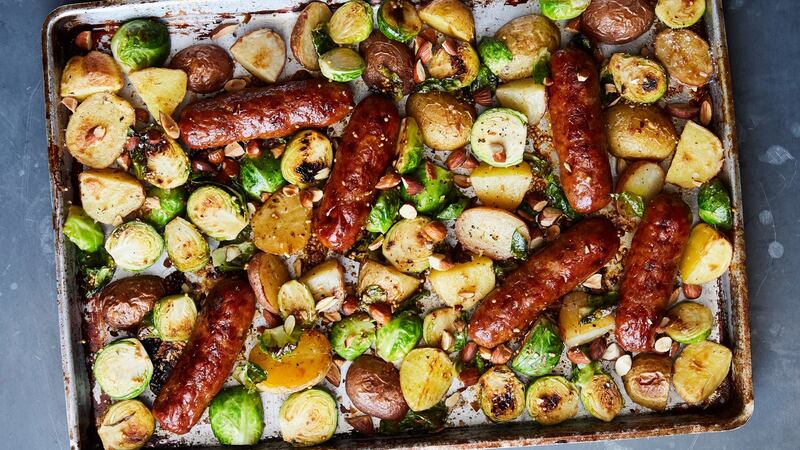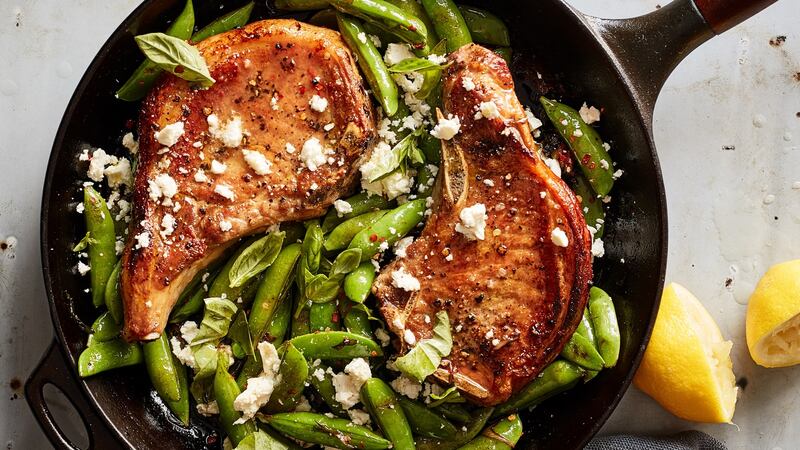Cooking with meat doesn’t need to be complicated. Here are four ways to pull together a comforting meaty dinner, using just one pot or pan, that should keep a full house happy.
HERBED WHITE BEAN AND SAUSAGE STEW
Serves six to eight. Cooking time 2½ hours

Here’s a meaty, cold-weather stew from Melissa Clark, laden with white beans, sausage, rosemary, thyme, cumin and garlic. Its deep flavour and complexity belies how easy it is to make. Pan-fry the sausages in a bit of olive oil, then sauté the vegetables in the drippings with cumin and tomato paste. Add plenty of water and the dried beans that, wait for it, you did not have to soak. Simmer until the house is fragrant and maybe the windows are fogged up and everyone’s looking at you hungrily, about two hours.
Ingredients
2 tbsp extra-virgin olive oil, plus more for serving
450g good quality sausage, left whole or sliced into thick medallions
1 tbsp tomato paste
½ tsp ground cumin
2 medium carrots, finely diced
2 celery stalks, finely diced
1 onion, chopped
2 garlic cloves, finely chopped
450g dried haricot beans, rinsed and picked through
2 tsp salt, or to taste
2 thyme sprigs
1 large rosemary sprig
1 bay leaf
2 tsp balsamic vinegar, plus more for serving
½ tsp black pepper, plus more to taste
Method
1. Heat oil in a large stockpot over medium-high heat. Add the sausage and brown until cooked through, about seven minutes. Using a slotted spoon, transfer to a plate lined with a paper towel.
2. Add the tomato paste and cumin to the pot. Cook, stirring, until dark golden, about two minutes. Add the carrots, celery, onion and garlic. Cook, stirring, until the vegetables have softened, about five minutes. Stir in the beans, 1.8 litres of water, salt, thyme, rosemary and bay leaf. Turn the heat up to high and bring to a boil. Then reduce heat to low and simmer gently until the beans are tender, about two hours, adding more water if needed to make sure the beans remain submerged.
3. When beans are tender, return the sausage to the pot. Simmer for five minutes. Stir in the vinegar and pepper. Taste and adjust seasoning. Ladle into warm bowls and serve drizzled with more vinegar and olive oil.
Tips: Make this in a slow cooker by adding all the ingredients, except the sausage and garnishes, and 1.6 litres of water to the machine. Cook on low for eight hours. (It holds well on low for two more hours.) When you're ready to serve, roast the sausage on a baking tray for about 20 minutes. Slice and add the sausage, as well as any accumulated juices from the pan, to the beans. Warm through and serve. You can fish out a cup or two of beans at the end, and either whizz them up in a food processor or mash them in a bowl, then return them to the pot for added creaminess.

DIJON AND COGNAC BEEF STEW
Serves four to six. Cooking time three hours.
This one is not difficult to prepare, but it cannot be rushed. Make it when you have time to indulge in the meditative qualities of chopping and sautéing, reducing and braising.
Ingredients
110g bacon lardons, as fatty as possible
1 large onion, finely diced
3 shallots, chopped
2 to 4 tbsp unsalted butter
900g braising/stewing beef, in cubes
2 tbsp flour
Salt and black pepper
120ml Cognac
470ml beef stock
8 tbsp Dijon mustard
4 tbsp whole-grain mustard
4 large carrots, peeled and cut into half-moon slices
200g mushrooms, stemmed, cleaned and quartered
60ml red wine
Method
1. Brown the lardons in a casserole over low heat, and cook until fat is rendered. Raise heat, and add onion and shallots. Cook until softened but not browned, 10 to 15 minutes. Use a slotted spoon to transfer to a large bowl.
2. If necessary, add two tablespoons butter to the pot to augment fat. Dust beef cubes with flour, and season with salt and pepper. Shake off excess flour, and place half the cubes in the pot. Cook over medium-high heat until well browned, almost crusty, on all sides, then transfer to a bowl with onions. Repeat with remaining beef.
3. Add Cognac to the empty pot, and cook, stirring, until the bottom is deglazed and the crust comes loose. Add stock, Dijon mustard and one tablespoon whole-grain mustard. Whisk to blend, then return meat and onion mixture to pot. Lower heat, partly cover, and simmer gently until meat is very tender, about 1½ hours.
4. Add carrots, and continue simmering for 30 minutes, or until slices are tender. As they cook, heat two tablespoons butter in medium skillet over medium-high, and sauté mushrooms until browned.
5. Stir mushrooms into stew along with remaining mustard and red wine. Simmer five minutes, then taste, and adjust seasoning. Serve hot.

SAUSAGES AND BRUSSELS SPROUTS WITH HONEY MUSTARD
Serves four. Cooking time 30 minutes
A simple recipe for sausages, Brussels sprouts and potatoes glazed with honey mustard, then roasted. The fat from the sausages coats and seasons the vegetables, and the honey encourages caramelization. It’s a sweet, salty, slightly acidic combination that may well join your weekly rotation, especially as you experiment with the vegetables, swapping in squash or broccoli, cherry tomatoes, carrots or cabbage.
Ingredients
450g sausages
450g Brussels sprouts, trimmed and halved lengthwise
450g small potatoes, halved
2 tbsp extra-virgin olive oil, plus more as needed
Salt and black pepper
4 tsp honey
1 tbsp Dijon mustard
1 tbsp yellow mustard seeds (optional)
Handful almonds or walnuts, chopped (optional)
Method
1. Heat oven to 220 degrees Celsius, or equivalent, and place a baking tray in the oven. Score the sausages in a few places on both sides, making sure not to cut all the way through. Transfer to a large bowl with the Brussels sprouts, potatoes and two tablespoons olive oil, and stir until coated. (If the mixture seems dry, add a little more oil.) Season with salt and pepper.
2. Spread the mixture in an even layer on the heated baking sheet, and arrange the vegetables cut-sides down. Roast 15 minutes, until the Brussels sprouts and potatoes start to soften. (The sausages will not be cooked through yet.)
3. Meanwhile, in a small bowl, stir together the honey, mustard and mustard seeds, if using.
4. Drizzle the honey mustard over the sausages and vegetables, and toss or shake to coat. Flip the sausages. Sprinkle with almonds, if using. Roast until the sausages are cooked through and the vegetables are golden and tender, another 10 minutes or so. Season to taste with salt and pepper.
Tips: Mustard seeds and nuts add texture and crunch, but they're not required. Use a sharp paring knife to prick a few holes in each of the sausages, so they don't burst.

PORK CHOPS WITH FETA, SUGAR SNAP PEAS AND MINT
Serves three to four. Cooking time 25 minutes
Melissa Clark came up with this amazing recipe of brawny seared pork chops rounded out with sweet sugar snap peas and loads of fresh mint. The feta, scattered over the dish at the end, melts into the pork and peas, and spikes the sauce with a delicious brininess. Balance is everything: The fresh lemon juice you add at the end cuts the richness and replaces it with an artful tang.
Ingredients
2 thick bone-in pork chops (about 450g each), or four large boneless chops
Salt and black pepper
1 tbsp extra virgin olive oil
1 tbsp unsalted butter
4 spring onions, white and green parts, thinly sliced, plus more for serving
300g sugar snap peas, trimmed
Bunch chopped fresh mint or basil, plus more for serving
Large pinch of chilli pepper flakes
110g crumbled feta
Lemon juice, for serving
Method
1. Season pork chops with salt and pepper. In a large frying pan, heat oil over medium-high until shimmering.
2. Add the pork chops to the pan and sear, without moving, until dark golden, four to five minutes per side. Lower heat, cover pan and cook the pork chops for three minutes longer. Transfer to a plate.
3. Return the pan to the stove and reduce heat to medium. Add butter to remaining oil in skillet, then add scallions and cook until lightly golden, two to three minutes. Add sugar snap peas, mint, chilli flakes and a pinch of salt, stirring everything to coat with pan juices.
4. Making space in the pan, return pork chops to pan, surrounding them with snap peas. If necessary, you can mound snap peas on top of pork, but make sure the meat sits directly on the bottom of pan. Scatter feta over pork and snap peas. Cover and cook over low heat until pork chops are just cooked through, three to six minutes longer.
5. Drizzle or squeeze lemon juice over the dish and sprinkle with more mint, scallions and black pepper before serving.
Tips: If you can lay your hands on some small-farm freerange pork for this dish, it's worth the expense, since the chops will be well larded with fat. If you can't, make sure to brown the meat deeply at the start of the recipe, creating a flavourful crust and sealing in the meat's juiciness. Mangetout or asparagus would be worthy substitutes for the sugar snap peas, depending on the season. – New York Times.















